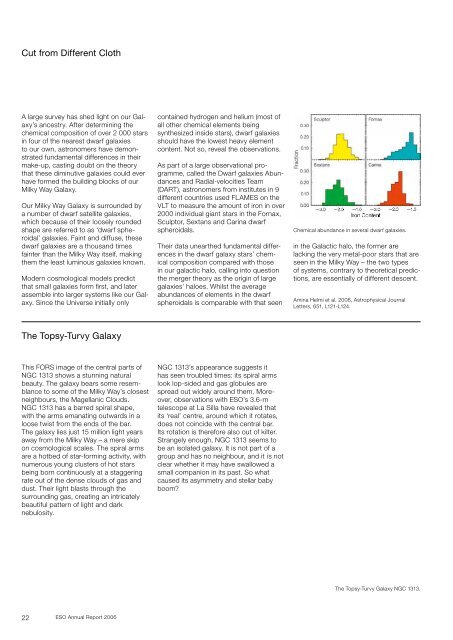Untitled - ESO
Untitled - ESO
Untitled - ESO
You also want an ePaper? Increase the reach of your titles
YUMPU automatically turns print PDFs into web optimized ePapers that Google loves.
Cut from Different Cloth<br />
A large survey has shed light on our Galaxy’s<br />
ancestry. After determining the<br />
chemical composition of over 000 stars<br />
in four of the nearest dwarf galaxies<br />
to our own, astronomers have demonstrated<br />
fundamental differences in their<br />
make-up, casting doubt on the theory<br />
that these diminutive galaxies could ever<br />
have formed the building blocks of our<br />
Milky Way Galaxy.<br />
Our Milky Way Galaxy is surrounded by<br />
a number of dwarf satellite galaxies,<br />
which because of their loosely rounded<br />
shape are referred to as ‘dwarf spheroidal’<br />
galaxies. Faint and diffuse, these<br />
dwarf galaxies are a thousand times<br />
fainter than the Milky Way itself, making<br />
them the least luminous galaxies known.<br />
Modern cosmological models predict<br />
that small galaxies form first, and later<br />
assemble into larger systems like our Galaxy.<br />
Since the Universe initially only<br />
The Topsy-Turvy Galaxy<br />
This FORS image of the central parts of<br />
NGC 1313 shows a stunning natural<br />
beauty. The galaxy bears some resemblance<br />
to some of the Milky Way’s closest<br />
neighbours, the Magellanic Clouds.<br />
NGC 1313 has a barred spiral shape,<br />
with the arms emanating outwards in a<br />
loose twist from the ends of the bar.<br />
The galaxy lies just 15 million light years<br />
away from the Milky Way – a mere skip<br />
on cosmological scales. The spiral arms<br />
are a hotbed of star-forming activity, with<br />
numerous young clusters of hot stars<br />
being born continuously at a staggering<br />
rate out of the dense clouds of gas and<br />
dust. Their light blasts through the<br />
surrounding gas, creating an intricately<br />
beautiful pattern of light and dark<br />
nebulosity.<br />
<strong>ESO</strong> Annual Report 006<br />
contained hydrogen and helium (most of<br />
all other chemical elements being<br />
synthesized inside stars), dwarf galaxies<br />
should have the lowest heavy element<br />
content. Not so, reveal the observations.<br />
As part of a large observational programme,<br />
called the Dwarf galaxies Abundances<br />
and Radial-velocities Team<br />
(DART), astronomers from institutes in 9<br />
different countries used FLAMES on the<br />
VLT to measure the amount of iron in over<br />
000 individual giant stars in the Fornax,<br />
Sculptor, Sextans and Carina dwarf<br />
spheroidals.<br />
Their data unearthed fundamental differences<br />
in the dwarf galaxy stars’ chemical<br />
composition compared with those<br />
in our galactic halo, calling into question<br />
the merger theory as the origin of large<br />
galaxies’ haloes. Whilst the average<br />
abundances of elements in the dwarf<br />
spheroidals is comparable with that seen<br />
NGC 1313’s appearance suggests it<br />
has seen troubled times: its spiral arms<br />
look lop-sided and gas globules are<br />
spread out widely around them. Moreover,<br />
observations with <strong>ESO</strong>’s 3.6-m<br />
telescope at La Silla have revealed that<br />
its ‘real’ centre, around which it rotates,<br />
does not coincide with the central bar.<br />
Its rotation is therefore also out of kilter.<br />
Strangely enough, NGC 1313 seems to<br />
be an isolated galaxy. It is not part of a<br />
group and has no neighbour, and it is not<br />
clear whether it may have swallowed a<br />
small companion in its past. So what<br />
caused its asymmetry and stellar baby<br />
boom?<br />
Chemical abundance in several dwarf galaxies.<br />
in the Galactic halo, the former are<br />
lacking the very metal-poor stars that are<br />
seen in the Milky Way – the two types<br />
of systems, contrary to theoretical predictions,<br />
are essentially of different descent.<br />
Amina Helmi et al. 006, Astrophysical Journal<br />
Letters, 651, L1 1-L1 4.<br />
The Topsy-Turvy Galaxy NGC 1313.

















